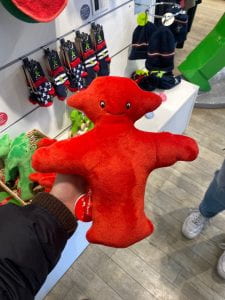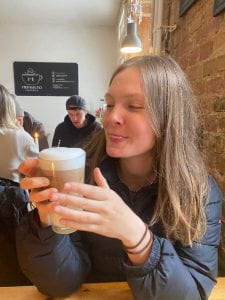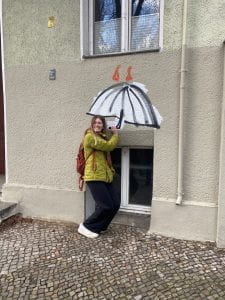Hello everyone,
I have always wanted to live in a city (outside of Portland that is) so I spent the entire winter break counting down the days until my departure. I flew from Portland to New York to Amsterdam and then finally touched down in Berlin. Before arrival, I had been told repeatedly about the long lines at customs, so I almost had a heart attack when I walked straight out of the Berlin airport. After 17 hours in the air, I was lacking any sort of brain function and had mindlessly erased the twenty minutes I spent in line in Amsterdam. So logically, I stood in the Berlin airport for a good few minutes thinking, how did I manage to skip customs, what am I going to say when I’m asked about how this happened? Eventually, I asked a lady who reminded me that I had in fact received a stamp and had ALREADY gone through customs. I guess this is where we reach the important lesson I learned on day one: Ask Questions. As left the airport and attempted to figure out the public transit, I asked many more…and then re-asked. I was told multiple locations of where to get onto the train and it was because I asked repeatedly that I didn’t hop on one going the wrong direction. I arrived at the IES center fully smelling of the plane, ready to shower and drink some water and after filling out some paperwork I was allowed into my room. The first day concluded with a short walking tour of Mitte (the neighborhood that I am in) and then all 20 of us went out to get food and drinks.
The following day we went on another walking tour of East Berlin. I must say that coming from Portland I am used to the rain and moderate cold but here, it seems the rain has been replaced with wind that runs through your clothes and freezes you to the bone.


On the walk, some new friends and I stopped in the Ampelmännchen merch store, where I got these two photos.


Additionally, they sell this underwear.
 (I THINK YES)
(I THINK YES)
SO WHAT ARE Ampelmännchen… Well, it quite literally means “traffic light man.” If you walk around Germany you cannot avoid interaction with the Ampelmännchen, you can take this a step further by visiting the merch store or perusing their website. Some people remark, on the Ampelmännchen’s “cuteness,” but I personally find myself drawn to the humor of it all. To me, the Ampelmännchen merch represents “quirkiness” at its finest. After doing some research I have come to understand that the little man in the hat is much more than a charmer but a symbol of reunification. In 1961 in East Germany, Karl Peglau, a traffic psychologist, designed the Ampelmännchen. Instead of making the symbol an abstract shape or rigid figure, Peglau turned to his knowledge of human behavior to create an effective sign. It was Peglau’s goal to capture the attention of the vulnerable population – such as elders and children. These people tend to think more graphically so he decided to make a personified symbol rather than an abstract one.


His first sketch even had fingers but with the help of his secretary Anneliese Wegner, he ended up with a chubby man in a large hat, a relatable symbol with plenty of room for the red and green lights to shine through. After the fall of the Wall in 1989, people assumed that the symbol would likely fade out of existence. This, however, was not the case, as the Ampelmännchen’s popularity has only continued to grow. Fons Hickman, a design professor, explains, “it’s not perfectly drawn, its proportions aren’t correct, but imperfection is what makes him sympathetic and makes sure he doesn’t seem too cold or rigid.” Now every time a light in West Berlin needs replacing it is replaced by the man with a hat and every time I have the urge to cross the street I can’t help but respect the request of the Ampelmännchen (plus here in Berlin pedestrians obey traffic laws, it is not acceptable to j walk or run across the street on a red even when there aren’t cars).
SO WHAT ABOUT THE BERLIN NIGHTLIFE
So when are you going to get into talking about Berlin nightlife, you might be wondering. Well, I’ll talk about it a bit here but I still do not know a lot. I have not attempted to get into Berghain (because I don’t want to stand in line for 3 hours and get rejected) and I haven’t tried for Kit Kat (but will perhaps eventually). To start out some of us got tickets to Sonny Fodera at Ritter Butzke (a nightclub inside a former factory). Here, it is looked down upon if you get to a club before 1 and on this specific occasion, the main performance was not scheduled to start until 2:00.

Here is a look at the entrance before the inside. ^^ It is also looked down upon to film in most clubs (some make you fully cover your phone’s front and back cameras.) After this night out I definitely want to I would like to experience some real techno (after the show a local Berliner informed me that Sonny Fodera is “Deep house” and not “Techno”).
After going to sleep at 4:30 in the morning (which seems to be on the earlier side for Berliners when they go out) I woke up to go on the IES planned “get to know the city scavenger hunt.” After a four-minute ride on the U-bahn, we ended up at Admiral-Brucke (here is a photo of a photo of a photo), a popular spot in the summer. We spent the next few hours exploring Kreuzberg, a district filled with art and graffiti, and interesting architecture. I definitely plan on returning.





FIRST SUNDAYS OF EVERY MONTH = FREE MUSEUM ENTRY
On the first Sunday of every month, many museums open their doors for free. This past Sunday, I had the chance to explore the Neues Museum and the Deutsches Historisches Museum. Currently, the permanent exhibition inside the Deutsches Historisches Museum is closed and so we ended up exploring their temporary “Roads Not Taken” exhibit. The exhibit’s concept is unique, instead of cataloging historic events from beginning to end, the show begins in 1989 and moves backward, ending in 1848. I have never been inside a more crowded museum, in fact, it got to the point where I was unable to actually see the display…
The Neues museum was wonderful, the interior is enough to be in total awe of but I am going to turn my attention to its current show that caught my eye.

ONE MILLION by Uli Aigner:

In 2014, at the age of 49, Uli Aigner set out to create one million white porcelain containers by the time of her natural death. After completing each piece a number is engraved on the object in the order of its production. Each object receives a QR code, allowing for its location to be tracked on a digital world map. Aigner believes that the journey of each item models globalization. It is her hope to see the vessels find homes all over the world. Right now some are located in a 5-star hotel, a Romanian orphanage, a cultural center in Inuvik, and the homes of many individuals; Aginer has used these objects as currency and traded them for vocal lessons and other various activities. Each year, Aigner has been producing 1000-1200 objects, if one breaks she still labels it, cataloging imperfections throughout her process. She explains that the creation of these vessels brings her “peace.” As a simple museum spectator looking at the thousands of porcelain pieces on display, Aginer hopes one will question,
- What does it mean to produce “something” and where does what we produce go?
- Art production versus production of consumer goods?
A SOLO TRIP TO THE TIERGARTEN (I will return and have more to say about this later on)
For the past 7 days, I have been in constant motion, saying yes, meeting new people, and seeing new places. Recognizing that I needed a moment alone, I decided to take a walk around the Tiergarten. The Tiergarten is located at the center of Berlin and is one of the city’s most frequented green spaces. Ranging 519 acres, the park is comparable to Central Park in New York.
A thin layer of snow from the night before had turned to ice, so I walked carefully through the park. It was pretty. I enjoyed walking along the sections of cobblestone, the bottom of my feet became familiar with the uneven stones. Most of the park was still blanketed by the grayness of winter so I found myself cherishing any bit of green. Although my legs became numb, I found the small sections of grass comforting; they seemed to confirm the coming of spring. But as I continued to walk, I couldn’t help but notice the rigid lines of the trees; the constant sound of traffic; each time I turned my head I could see buildings and groups of people walking by. Two nights before leaving Portland, my mom told me to “come outside” and “see the stars.” That night, looking up at the sky, I was able to count the number of stars I could see on my hands. Looking up at the almost blank sky, I felt a hint of sadness, but I forgot about this momentary reaction as soon as I returned inside.
Oddly enough, three nights ago I had the same interaction. While walking home, one of my friends remarked on the few visible stars in the sky. I found myself surprised by the excitement people had for seeing a single star, because have the privileged of seeing many. Through living in Walla Walla for the past two and a half years, I have become accustomed to silence, the ability to easily access nature, and look at the stars. While I walked through the Park, I longed for silence but recognized that this was impossible, I wanted to be deep in nature but knew that was unattainable. Prior to coming here, I was absolutely certain that living in a city would fulfill me, now I believe that it is the opposite. Anyways, I guess what I mean to say is that since being in the city I have found an appreciation for things I have taken for granted… but for at least the next four months I am certain I will also develop an appreciation for the single stars in the sky.
Hi, this is a comment.
To get started with moderating, editing, and deleting comments, please visit the Comments screen in the dashboard.
Commenter avatars come from Gravatar.